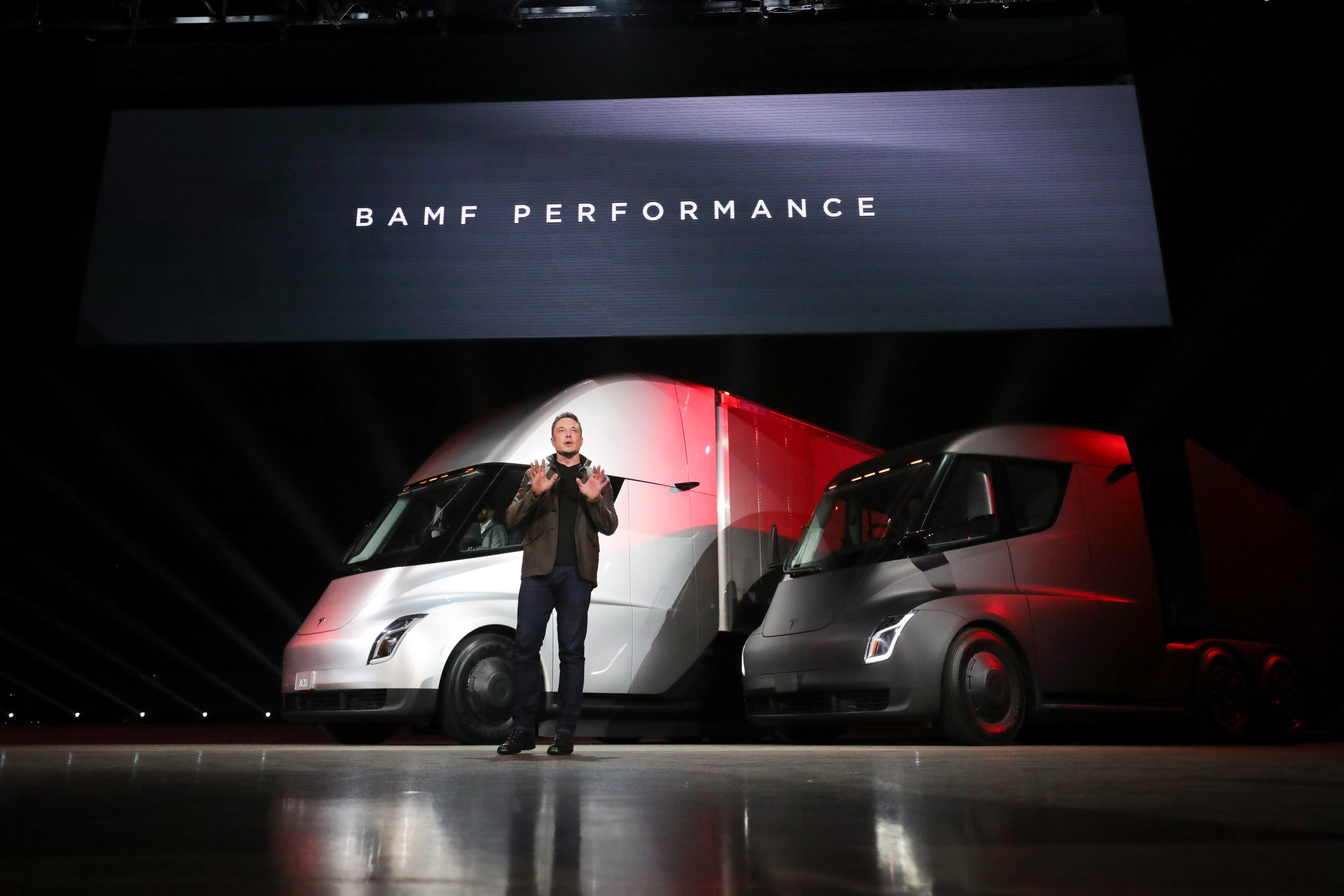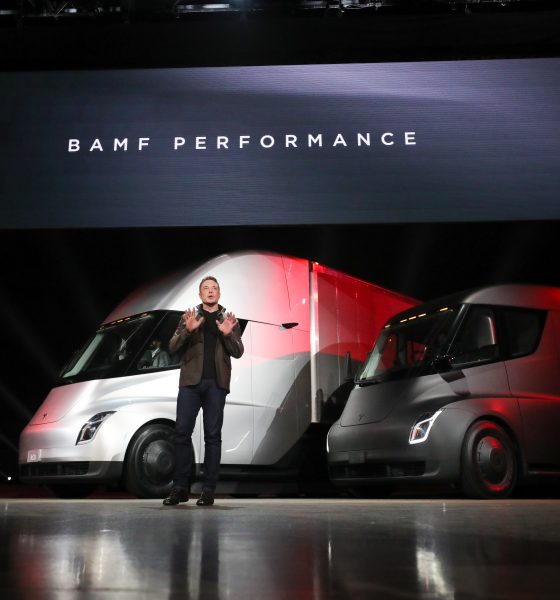

News
Tesla’s battery supply constraint is ending, price parity with gas cars is at hand
Tesla’s Semi is coming, and it will be here sooner than expected. But the production of the vehicle could be pointing to one thing: Tesla is no longer battery constrained.
Past the face value portion of the story, something much bigger is happening. While the Semi entering a “volume production” phase is big news, the development of the commercial vehicle comes at a time where battery production for Tesla seems to be the main focus of the electric automaker.
In Q3 2019, CEO Elon Musk indicated that a shortage of battery cells primarily drove the Semi’s delay. If Tesla wanted to start producing the Semi, the company would have to make cells available for it. That would mean one thing: cutting back on cells utilized for Tesla’s mass-market vehicles, which at the time was the Model 3.
Building the Semi before a sufficient battery production and supply chain was established would have been detrimental to the company’s long-term plans. Of course, the Model 3 has been Tesla’s most popular vehicle since it started deliveries in 2017. Its affordability has helped Tesla reach a new market, which was all apart of Elon’s original Master Plan.

With the Model Y now being produced in Fremont, Tesla now has two mass-market vehicles that are affordable by a vast segment of the population. Ultimately, this means that Tesla needed to levy a majority of its available lithium-ion cells for the Model 3 and Model Y. Unfortunately, the Semi just was not a priority over those two cars. Why would it be? The Model 3 (and Model Y now) are Tesla’s two top sellers. Therefore, the battery needs pointed toward the 3 and the Y, with Semi production being dependent on the availability of battery cells.
If we think about Musk’s statement from Q3, he indicated that the Semi production would be based on when Tesla could manufacture the appropriate amount of lithium-ion batteries to power the Class 8 vehicle. Although demand for the 3 and the Y continues to increase, so is Tesla’s production rate, and it could be indicative that the Silicon Valley-based electric car maker is pumping out enough batteries to produce all of its vehicles without any worries of possible cell shortages.
Ultimately, this idea could lead to another significant development in the EV world as a whole, and that is price parity.
For a long time, analysts have pinpointed the electric vehicle movement’s price parity at $100/kWh for battery cell production. This means that when cells are produced at a high enough rate, batteries will be lower in cost. Then, electric cars will be the same price as gas-powered machines, making the argument of “EVs are too expensive” obsolete.
The Tesla Model 3 Performance utilizes a 75 kWh battery pack. If battery production is at $120/kWh, this would mean that the Model 3 Performance’s battery pack costs $9,000 to produce. The car’s $54,990 price tag, hypothetically at $120 per kWh, is made up of a battery pack that costs about $9,000.
If Tesla could produce batteries at a high enough rate where the cost per kWh could come down to $100, the battery pack would only cost $7,500 to build, meaning an additional $1,500 comes off the price of the vehicle altogether. Tesla’s goal is to produce enough battery cells to justify this pricing point for its cars. Also, $100/kWh is just the price parity point, and not where the cost will ultimately end up. If demand continues to increase and battery cell production keeps growing, the cost could get even lower.
If Tesla has enough batteries to justify producing mass quantities of the Model 3 and Model Y, along with the sizable battery packs of the Semi, parity could be coming sooner than expected. Most analysts indicated 2023 as the year when battery production would be on a level where EV prices could compete with their petrol-powered counterparts.
However, if the Semi is ready for a production run now, Tesla may have enough cells to introduce a more affordable pricing model for its vehicles. This could, in turn, lead to even higher production numbers, increased demand, and a sharp increase in the company’s delivery numbers.
The announcement of the Tesla Semi meant much more than the company producing its commercial vehicle. It means batteries are no longer in restricted amounts, the technology is improving, and the prices of the company’s vehicles could be coming down soon. With this, it appears that Elon Musk’s endgame with his Master Plan may be getting closer to reality.

Elon Musk
Tesla’s Elon Musk: 10 billion miles needed for safe Unsupervised FSD
As per the CEO, roughly 10 billion miles of training data are required due to reality’s “super long tail of complexity.”

Tesla CEO Elon Musk has provided an updated estimate for the training data needed to achieve truly safe unsupervised Full Self-Driving (FSD).
As per the CEO, roughly 10 billion miles of training data are required due to reality’s “super long tail of complexity.”
10 billion miles of training data
Musk comment came as a reply to Apple and Rivian alum Paul Beisel, who posted an analysis on X about the gap between tech demonstrations and real-world products. In his post, Beisel highlighted Tesla’s data-driven lead in autonomy, and he also argued that it would not be easy for rivals to become a legitimate competitor to FSD quickly.
“The notion that someone can ‘catch up’ to this problem primarily through simulation and limited on-road exposure strikes me as deeply naive. This is not a demo problem. It is a scale, data, and iteration problem— and Tesla is already far, far down that road while others are just getting started,” Beisel wrote.
Musk responded to Beisel’s post, stating that “Roughly 10 billion miles of training data is needed to achieve safe unsupervised self-driving. Reality has a super long tail of complexity.” This is quite interesting considering that in his Master Plan Part Deux, Elon Musk estimated that worldwide regulatory approval for autonomous driving would require around 6 billion miles.
FSD’s total training miles
As 2025 came to a close, Tesla community members observed that FSD was already nearing 7 billion miles driven, with over 2.5 billion miles being from inner city roads. The 7-billion-mile mark was passed just a few days later. This suggests that Tesla is likely the company today with the most training data for its autonomous driving program.
The difficulties of achieving autonomy were referenced by Elon Musk recently, when he commented on Nvidia’s Alpamayo program. As per Musk, “they will find that it’s easy to get to 99% and then super hard to solve the long tail of the distribution.” These sentiments were echoed by Tesla VP for AI software Ashok Elluswamy, who also noted on X that “the long tail is sooo long, that most people can’t grasp it.”
News
Tesla earns top honors at MotorTrend’s SDV Innovator Awards
MotorTrend’s SDV Awards were presented during CES 2026 in Las Vegas.

Tesla emerged as one of the most recognized automakers at MotorTrend’s 2026 Software-Defined Vehicle (SDV) Innovator Awards.
As could be seen in a press release from the publication, two key Tesla employees were honored for their work on AI, autonomy, and vehicle software. MotorTrend’s SDV Awards were presented during CES 2026 in Las Vegas.
Tesla leaders and engineers recognized
The fourth annual SDV Innovator Awards celebrate pioneers and experts who are pushing the automotive industry deeper into software-driven development. Among the most notable honorees for this year was Ashok Elluswamy, Tesla’s Vice President of AI Software, who received a Pioneer Award for his role in advancing artificial intelligence and autonomy across the company’s vehicle lineup.
Tesla also secured recognition in the Expert category, with Lawson Fulton, a staff Autopilot machine learning engineer, honored for his contributions to Tesla’s driver-assistance and autonomous systems.
Tesla’s software-first strategy
While automakers like General Motors, Ford, and Rivian also received recognition, Tesla’s multiple awards stood out given the company’s outsized role in popularizing software-defined vehicles over the past decade. From frequent OTA updates to its data-driven approach to autonomy, Tesla has consistently treated vehicles as evolving software platforms rather than static products.
This has made Tesla’s vehicles very unique in their respective sectors, as they are arguably the only cars that objectively get better over time. This is especially true for vehicles that are loaded with the company’s Full Self-Driving system, which are getting progressively more intelligent and autonomous over time. The majority of Tesla’s updates to its vehicles are free as well, which is very much appreciated by customers worldwide.
Elon Musk
Judge clears path for Elon Musk’s OpenAI lawsuit to go before a jury
The decision maintains Musk’s claims that OpenAI’s shift toward a for-profit structure violated early assurances made to him as a co-founder.

A U.S. judge has ruled that Elon Musk’s lawsuit accusing OpenAI of abandoning its founding nonprofit mission can proceed to a jury trial.
The decision maintains Musk’s claims that OpenAI’s shift toward a for-profit structure violated early assurances made to him as a co-founder. These claims are directly opposed by OpenAI.
Judge says disputed facts warrant a trial
At a hearing in Oakland, U.S. District Judge Yvonne Gonzalez Rogers stated that there was “plenty of evidence” suggesting that OpenAI leaders had promised that the organization’s original nonprofit structure would be maintained. She ruled that those disputed facts should be evaluated by a jury at a trial in March rather than decided by the court at this stage, as noted in a Reuters report.
Musk helped co-found OpenAI in 2015 but left the organization in 2018. In his lawsuit, he argued that he contributed roughly $38 million, or about 60% of OpenAI’s early funding, based on assurances that the company would remain a nonprofit dedicated to the public benefit. He is seeking unspecified monetary damages tied to what he describes as “ill-gotten gains.”
OpenAI, however, has repeatedly rejected Musk’s allegations. The company has stated that Musk’s claims were baseless and part of a pattern of harassment.
Rivalries and Microsoft ties
The case unfolds against the backdrop of intensifying competition in generative artificial intelligence. Musk now runs xAI, whose Grok chatbot competes directly with OpenAI’s flagship ChatGPT. OpenAI has argued that Musk is a frustrated commercial rival who is simply attempting to slow down a market leader.
The lawsuit also names Microsoft as a defendant, citing its multibillion-dollar partnerships with OpenAI. Microsoft has urged the court to dismiss the claims against it, arguing there is no evidence it aided or abetted any alleged misconduct. Lawyers for OpenAI have also pushed for the case to be thrown out, claiming that Musk failed to show sufficient factual basis for claims such as fraud and breach of contract.
Judge Gonzalez Rogers, however, declined to end the case at this stage, noting that a jury would also need to consider whether Musk filed the lawsuit within the applicable statute of limitations. Still, the dispute between Elon Musk and OpenAI is now headed for a high-profile jury trial in the coming months.








